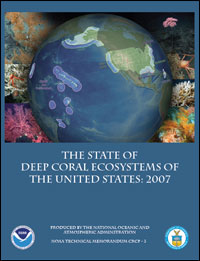-
Home
-
Data & Publications
-
Regional Portals
- About Regional Portals
- Florida
- Navassa Island
- Puerto Rico
- Flower Garden Banks
- U.S. Virgin Islands
- American Samoa
- Commonwealth of the Northern Mariana Islands
- Federated States of Micronesia
- Guam
- Main Hawaiian Islands
- Republic of the Marshall Islands
- Northwestern Hawaiian Islands
- Republic of Palau
- Pacific Remote Island Areas
-
CRCP Activities
- Glossary
The State of Deep Coral Ecosystems of the United States

The National Oceanic and Atmospheric Administration (NOAA) today released a new report, The State of Deep Coral Ecosystems of the United States, prepared by NOAA’s Coral Reef Conservation Program. The report, written by experts in seven regions around the country, provides an up-to-date assessment of deep coral ecosystems in U.S. waters including: the biology of deep corals and their associated species, their spatial distribution, the stressors that may threaten their survival, current management measures, and regional priorities for future research.
The State of Deep Coral Ecosystems of the United States report shows that these habitats, found at depths ranging from 50-3000+ meters, may be much more extensive and important to ocean ecosystems than previously known. NOAA works with Regional Fishery Management Councils, Fishery Science Centers, other Federal partners, academia, the environmental and fishing communities and other stakeholders to understand and protect these unique ecosystems.
Current Threats to U.S. Deep Coral Ecosystems:
- Fishing gear, especially bottom trawling
- Oil and gas exploration and development
Threats Requiring Further Research:
- Bottom trawling
- Climate change and ocean acidification
The State of Deep Coral Ecosystems of the United States (full report, pdf 27MB):
- Front Cover and Table of Contents (pdf, 426KB)
- Chapter 1: Introduction and Overview ( pdf, 6MB)
- Chapter 2: Alaska ( pdf, 4.6MB)
- Chapter 3: West Coast ( pdf, 6MB)
- Chapter 4: Hawaii and Western Pacific ( pdf, 2MB)
- Chapter 5: Northeast ( pdf, 2MB)
- Chapter 6: Southeast ( pdf, 4MB)
- Chapter 7: Gulf of Mexico ( pdf, 3MB)
- Chapter 8: Caribbean ( pdf, 3MB)
Citation: Lumsden SE, Hourigan TF, Bruckner AW, Dorr G (eds.) 2007. The State of Deep Coral Ecosystems of the United States. NOA Technical Memorandum CRCP-3. Silver Spring MD
For more information contact:
Thomas F. Hourigan, Ph.D.
tom.hourigan@noaa.gov
1315 East-West Highway
SSMC-III
Silver Spring, MD 20910


